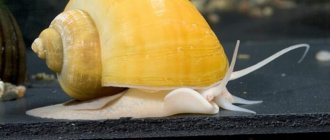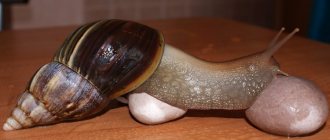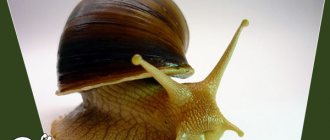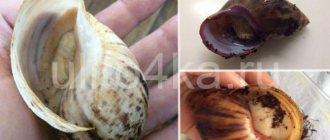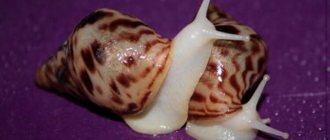Ampullaria aquarium snails are popular aquarium inhabitants native to South America. In nature, these mollusks reach a diameter of 11 cm, and in aquariums they rarely grow more than 6 cm. Reproduction of ampullaria in a home aquarium is possible if they are provided with a quality life. Unlike many small snails, giants rarely start laying eggs in unsuitable conditions.
Sex differences
Only females lay eggs.
This type of mollusk is heterosexual, and in order to produce offspring, the presence of males and females is necessary, while the vast majority of other aquarium snails are hermaphrodites. It is impossible to determine the gender of pets. There are no visible differences between individuals of different sexes . It is possible to distinguish a male apple from a female only at the moment of mating, during which he always remains on top. You can also determine the female by noticing which of the pets lays eggs.
To have individuals of both sexes in the aquarium, you need to buy at least 6 yellow snails. Among such a number, at least one individual of the opposite sex is ensured. If the ampullaria still do not reproduce, you need to check the conditions of their detention and, if they are in order, try to introduce a few more new snails.
Why ampularia do not reproduce
Mating and reproduction is a natural biological process that affects all living things. If there are no offspring from domestic gastropods for a long time, it is worth analyzing the following points:
- Both sexes are missing. If in doubt, it's better to buy a few more pieces;
- Snails have not yet reached reproductive age. Mollusks begin to breed no earlier than 1 year;
- Insufficient ambient temperature. The stimulus for sexual activity is an increase in temperature. At low rates, the mollusks will live, but the reproduction of heat-loving ampullary snails will be impossible.
- Lack of nutrition. It is important to make sure that the clams are not hungry.
- Little light. Ampoules need lighting at a rate of 1 W per liter.
By creating the right conditions for your pets, you can easily get offspring from them
To breed these bright snails that look like colorful pebbles, no special skills or labor are required. Natural instinct will do its job on its own. It is necessary to organize conditions favorable for gastropods and add observation skills to help baby ampullaries be born.
Was this information useful to you? Share in the comments!
Conditions necessary for reproduction
Breeding ampularia at home is not difficult if certain conditions are created. They are necessary not only for producing offspring, but also simply for the quality of life of the ampoule. The main parameters necessary for the reproduction of mollusks are these three:
- Quality feeding. Snails cannot swim, which is why they feed on food from the bottom. If bottom dwellers or fish swimming on the surface overtake their armored neighbors and collect food from the bottom, then the latter will begin to eat plants, but they will not have enough of them. Due to a lack of nutrients, the snails will be quite weak and will not be able to produce full-fledged offspring.
- Keeping the water clean. Like fish, ampullaria require regular water changes in your home pond and mandatory cleaning of the bottom. This should be done at least once every 7 days. A quarter of the aquarium's volume needs to be replaced.
- The presence of space between the aquarium lid and the water. If there is not enough volume under the glass (lid) above the water, then the females will have nowhere to lay eggs, and reproduction will be impossible .
If all the necessary conditions are available in the aquarium, propagation of ampularia will not cause any difficulties. Snails, having reached sexual maturity, quickly begin to mate and lay eggs.
Video
CULTIVATION OF AMPULARIES personal experience.
5 secrets of ampullaria and my aquarium without hassle
AMPULAR BREEDING is my experience. How to breed and preserve snails, keeping ampularia | SNAILS
Ampullaria snails. Reproduction of ampularia. Aquarium.
Mating and laying eggs
Mating occurs after the snail has reached sexual maturity. This is usually indicated by its size, which reaches 4 cm. The type of ampoule (yellow, brown, black) does not matter. This indicator is the same for everyone. On average, ampularia are ready to mate at the age of 12 months. Giant clams live up to 4 years.
The male and female stick together with their soles, and at this moment fertilization occurs. The male is always on top, because of which it will be possible to determine the sex and mark it, so that in the future you will have an idea of what sex there are how many snails there are.
Video: Mating ampularia
After mating, the female climbs up the glass and crawls out of the water. In nature, it lays eggs on plants above water or on rocks on the shore. In a home aquarium, the snail uses glass above the water surface or a lid for this. If eggs fall into the water, they will die immediately . Even immediately removing it from the water, it will be impossible to save the embryos.
The most convenient way is to make a special plate for the snail to spawn. It is made of organic glass, which is glued to a strong suction cup using silicone sealant for aquariums. When it is noticed that mating has occurred, the plate is placed in the aquarium away from the lighting system so that it does not overheat the eggs. In addition, when attaching the glass for caviar, you need to position it in such a way that the fish cannot reach it. Many species will happily eat eggs if given the opportunity.
Ampularia spawning occurs in the evening or at night and always in the dark. When the ampullaria has laid eggs, it uses its foot to push the eggs towards each other so that they form a dense clutch. If the place chosen for spawning is good, then the ampullaria will lay eggs in it constantly.
Shipping
The best way to transport apple snails is to place them in a plastic box with damp synthetic filter wool or paper towels. Snails in such a container are perfectly protected from damage to the shell and, since snails breathe air, they can go for days without water. It is very important that the container has openings for access to fresh air. Large apple apples can simply be wrapped in newspaper and placed in a paper bag. Transport in water-filled plastic bags is only necessary for small snails.
In 1758, Linnaeus classified Ampullariidae as land snails, placing Pila ampullacea in the genus Helix. His delusion is based on the fact that he had never seen a living specimen, it only had a shell.
In 1797, Humphrey tried to introduce the generic name Pomus and described 5 species that he classified in this genus. But according to Dall (1904), his work was published anonymously, not for sale, without the names of the author or publisher, and did not comply with the rules of classification. All this has led to the generic name Pomus being considered a misnomer. In 1798, Roding proposed the generic name Pila (together with Helix ampullacea as a species, described by Dall (1904)).
This description of the genus did not fully comply with the rules of classification and therefore was limitedly applied only to the apple apples of the Old World (apparently the author means the Eastern Hemisphere), with the exception of the West African genera Saulea (Gray, 1867) and Afropomus (Pilsbry and Bequaert, 1927).
In 1799, Lamarck used the name Ampullaria for one species (Helix ampullacea), reducing the Ampullaria species to a single species. However, Dall (1904) described Helix ampullacea as an example of a species of the genus Pila, interpreting Ampullaria (Lamarck, 1799) as a later synonym of Pila (Roding, 1798), despite his description of Nerita urceus (Muller, 1774) as a species of Ampullaria. In March 1810, Perry introduced the genus Pomacea (an example of the species of the genus Pomacea maculata), into which he placed the American species.
In the same year (1810), a few months after Perry's publication, Montfort proposed the generic name Ampullarius, an unjustified correction of the name Ampullaria. The generic name Ampullarius is a late subjective synonym of Pomacea (Perry, 1810) (ICZN OPINION 13). Unfortunately, Ampullarius continues to be misused in trading.
In 1824, Gray proposed the family name Ampullariidae (from the genus Ampullaria (Lamarck, 1799)), including the Old and New World apple apples together.
Preston (1915) proposed the family name Pilidae (from the genus Pila (Roding, 1798)) to replace the family name Ampullariidae, considering the generic name Ampullaria (Lamarck, 1799) to be a late synonym of Pila (Roding, 1798). However, the family name Ampullariidae (Gray, 1824) is approved as correct by the International Commission on Zoological Nomenclature OPINION 1913, instead of Pilidae (Preston, 1915) in the Official Index of Rejected and Invalid Family-Group Names in Zoology).
Text and illustrations: Stijn Ghesquiere Translation: Timothy Slavkin
Appearance of caviar
The laying of ampularia is similar to a bunch of grapes.
The color of the eggs is whitish-transparent. The diameter of the eggs is 2 mm. They are deposited in clusters similar to grapes. The eggs are elastic and soft to the touch. As they mature, the eggs change color, becoming dark. Before the young snails hatch, the clutch turns out to be almost black. At such a moment, the caviar looks like a stone.
Diseases
Aquarium ampullaria snails are considered one of the hardiest and most unpretentious, but despite these characteristics, the mollusks can get sick. The most common ailments are:
- Coma - develops when the reservoir is overcrowded, which causes oxygen deficiency. Because of this, mollusks hibernate, burying themselves in the substrate. Increasing the volume of the aquarium or moving some of the inhabitants will help solve the problem.
- Destruction of the shell - occurs due to soft water. To restore the shell, you should increase the hardness and introduce lettuce and cabbage into the diet.
Conditions for the full development of caviar
The temperature of the aquarium water determines the rate of maturation of snail eggs. If it is heated to a temperature of 24-26 degrees, then the offspring will appear 2 weeks after the eggs are laid. When the water temperature is only up to 18-20 degrees, it takes 3 weeks for the offspring to fully develop.
The humidity in an aquarium with a lid for caviar is always sufficient. If the home pond is covered with a net, then until the eggs ripen it should be covered with organic glass. Without this, the air humidity will be insufficient, and the clutch will simply dry out, causing the embryos inside the eggs to die.
How to regulate the number of snails in an aquarium
Despite the benefits of shellfish, you need to monitor their quantity. Too many snails pollute the water, spoil plants and eat fish eggs. Owners resort to several methods of getting rid of shellfish:
- Mechanical - young animals are collected, crushed and fed to other inhabitants of the reservoir.
- Thermal - the masonry is frozen, crushed and fed to fish and snails.
- Biological - they keep predatory fish (cichlids, barbs, tetraodons) or helenas, which eat other mollusks and caviar.
To catch shellfish, traps are used - a cabbage leaf scalded with boiling water is placed on the bottom, and in the morning snails will gather on it. Or they take a plastic bottle and make a hole for gastropods so that fish cannot get in.
There are also chemical and electrical methods of getting rid of snails, but then the entire aquarium with other inhabitants will suffer. Otherwise, they breed snails that are unable to reproduce in fresh water.
Caring for young animals
You need to breed snails knowing how to care for the resulting offspring. Young snails fall or slide into the water after hatching and need good nutrition. The fish food that falls to the bottom is not enough for them, and the aquarium plants for young animals are too tough. The main diet for growing ampullaria is scalded lettuce, chopped duckweed and scalded cyclops. This feeding will stimulate rapid growth of shellfish and maintain their health.
The peculiarity of caring for young animals is isolation from predators and proper feeding.
If there are Helena snails in the aquarium where the giants breed, they can eat young ampullaria, as they are predators . For adult individuals, helenas are less dangerous, as they are significantly smaller in size. In such a situation, it is necessary to separate the predator from the young individuals or create a separate spawning aquarium for breeding.
Ampoules breed all year round. They do not have a clear reproduction cycle. By creating the right conditions for pets, it is easy to get offspring from them. Having found an area for selling these armored giants, you can have a small income, but you won’t be able to make serious money from these aquarium inhabitants, even if you breed them in large quantities.
Description
Although the most common color is yellow, they still come in many different colors. In addition to yellow ampoule, you can find white, brown and even almost black. Now blue ones have become fashionable, but they are not particularly different from yellow ones in keeping and breeding.
When you buy one, it is important to remember that it grows much larger than other snails. They are sold quite small, up to 2.5 cm in diameter, but they can grow to a size of 8-10 cm.
There are larger ones that have been very well fed, and they become so large that they can compete in size with other giants - marise snails.
The aquarium contains several different species, which differ from each other in the shape of their shell. Life expectancy in an aquarium is 2 years.
Making fertilizer
If the snail has laid eggs, you can use them as additives for other shellfish. To do this you need to take the following steps:
- Achatina eggs are washed from soil residues, placed in a plastic bag or plastic container, and sent to the freezer.
- After 2 - 3 days they are placed on a radiator to dry. After 1 - 3 days (large eggs dry more slowly), they should begin to crumble. This will indicate the completion of the drying process.
- Some snail breeders dry the masonry without freezing. Dried eggs should be ground and given to snails in any quantity as independent feeding. Or as part of a calcined mixture.
- To prevent Achatina snail eggs from deteriorating during the drying process, they should be provided with normal ventilation.
But if they begin to darken, become moldy and smell unpleasant, it is absolutely forbidden to give such feeding to snails.
Content
with feeding ampularia ; they are actually omnivorous. In nature, they apparently feed mainly on plant foods, but in an aquarium they sometimes prefer food of animal origin, just like aquarium fish. But despite the fact that these are very nimble snails, they cannot compete with fish when feeding, and in a general aquarium they may well be constantly hungry. Therefore, it is not worth keeping these snails in an aquarium with expensive or valuable plants. First of all, they can destroy young plants with tender leaves. And given the mass of the snail, sometimes they simply break. In search of food, they often turn over the soil, digging up small plants.
Therefore, it is better to keep several of these interesting mollusks in large, tropical general aquariums, with large plants. In community aquariums, it is advisable to feed them additionally with plant foods that fish do not eat. In this capacity, you can use lettuce, carrots, cabbage, cucumber (not pickled, of course). Rough food that is difficult for them to handle must first be boiled with boiling water. Occasionally, in order not to spoil the water, you can give a little white bread. In this case, they will be full and will not try to spoil the plants.
Considering that these snails are dioecious, and it is difficult to determine the sex, their number in the aquarium should be at least three if offspring are expected to be obtained. There they will maintain cleanliness, destroying algae from glass and plants and the remains of fish food.
In general, these mollusks are very unpretentious. The composition of the water is not very important for them, but it should not be too soft. In soft water, the shell of adult ampularia is destroyed. Indentations resembling sores form on the surface of the shell. True, this did not affect the behavior of the snails in any way. Temperatures can range from 15 to 33°C, but the optimum is above 20°C, so they are suitable for large tropical aquariums.
If you keep ampullaria at low temperatures, they become lethargic. They move slowly and do not reproduce. Although at low temperatures they can live up to 3-4 years. At high temperatures, the lifespan of ampularia is reduced to 1-2 years, due to the acceleration of metabolic processes. But watching them, in this case, is much more interesting. They lead an active lifestyle and often reproduce.
Ampularia in a community aquarium cannot harm any fish, unless by accident. Small peaceful fish also do not pose a threat to these snails. Unless, when they are hungry, they pull their mustaches. But ampullaria quickly adapt to this and keep their whiskers closer to the shell, removing them at the slightest threat. It’s not worth keeping these mollusks with large, aggressive fish; if they don’t kill you, they won’t let you live in peace. The young of these snails are eaten by any type of aquarium fish.
When keeping ampullaria in a general aquarium, if there is a need to treat fish in it, you need to take into account that medications that are safe for fish can be fatal for snails. This is due to the fact that snails are sometimes biologically closer to fish parasites than to the fish themselves. Therefore, when treating fish in a community aquarium, snails must be removed during treatment. Three or four of these adult snails can temporarily live in a five-liter jar, you just need to cover the jar with glass so that they don’t crawl out at night. The glass must be heavy enough or a weight must be placed on top. There must be a gap between the glass and the jar to allow fresh air to enter.
Compatibility
They live well in a community aquarium and are even capable of procreation. It is better for them to choose calm and peaceful fish as neighbors who will not bite their beautiful mustaches. Although if this happens, then you shouldn’t worry, because they can easily regenerate any part of their body. And this in no way affects how long the snail lives in an aquarium.
Undesirable neighbors for them will be all types:
- barbs;
- labyrinthine;
- cichlids.
The aquarium snail, like any other snail, is a bottom dweller, although it often floats on the surface with its mouth up collecting leftover food. Thus, its natural competitors are other inhabitants of the bottom.
Giant, like other colored ampullaria, can be pulled out of the shell by loaches, cichlids and other species of fish. Snails that feed on the bottom often float to the surface from attacks by Ancistrius and other bottom-dwelling catfish.
Aquarium crayfish (large species) pose some threat to this, so keeping them in the aquarium at the same time is not recommended.
Shellfish can coexist with shrimp. Although shrimp in large quantities will cause some discomfort due to their vital activity. And also the masonry of ampullaria can suffer from them.
The benefits or harms of keeping ampularia at home are very conditional. On the one hand, they are good cleaners, on the other hand, they prevent the growth of young shoots of plants that they like to feast on. But color variations can complement any design of your artificial pond, which more than compensates for their love for the delicate leaves of plants.
Interesting to know
Most aquarists have not seen how ampullaria reproduce, because they mate spontaneously, and it is difficult to catch snails doing this. The female emerges at night and calmly lays eggs above the water. The laying of ampullaria usually comes as a surprise to the aquarist.
If the shell of an ampularia collapses, this may indicate excessive water hardness. It will not collapse immediately, but gradually. First, the edges of the shell are destroyed, and only then can cracks be detected in the center.
It is almost impossible to determine the sex of ampullaria; sometimes this can only be done by experienced aquarists who have been practicing ampularia propagation for many years. How to determine the sex of snails can be determined by their protective cover; it is generally believed that males press it more tightly to the shell. It’s better to remember which snail was seen laying eggs, and use it for planned reproduction in the future.
If the snail has surfaced and captures air with its special proboscis, there is no need to worry; thanks to the structure of this organ, it breathes air. Ampullaria in an aquarium often do this and it doesn’t mean absolutely anything, but it’s very interesting to observe this behavior.
